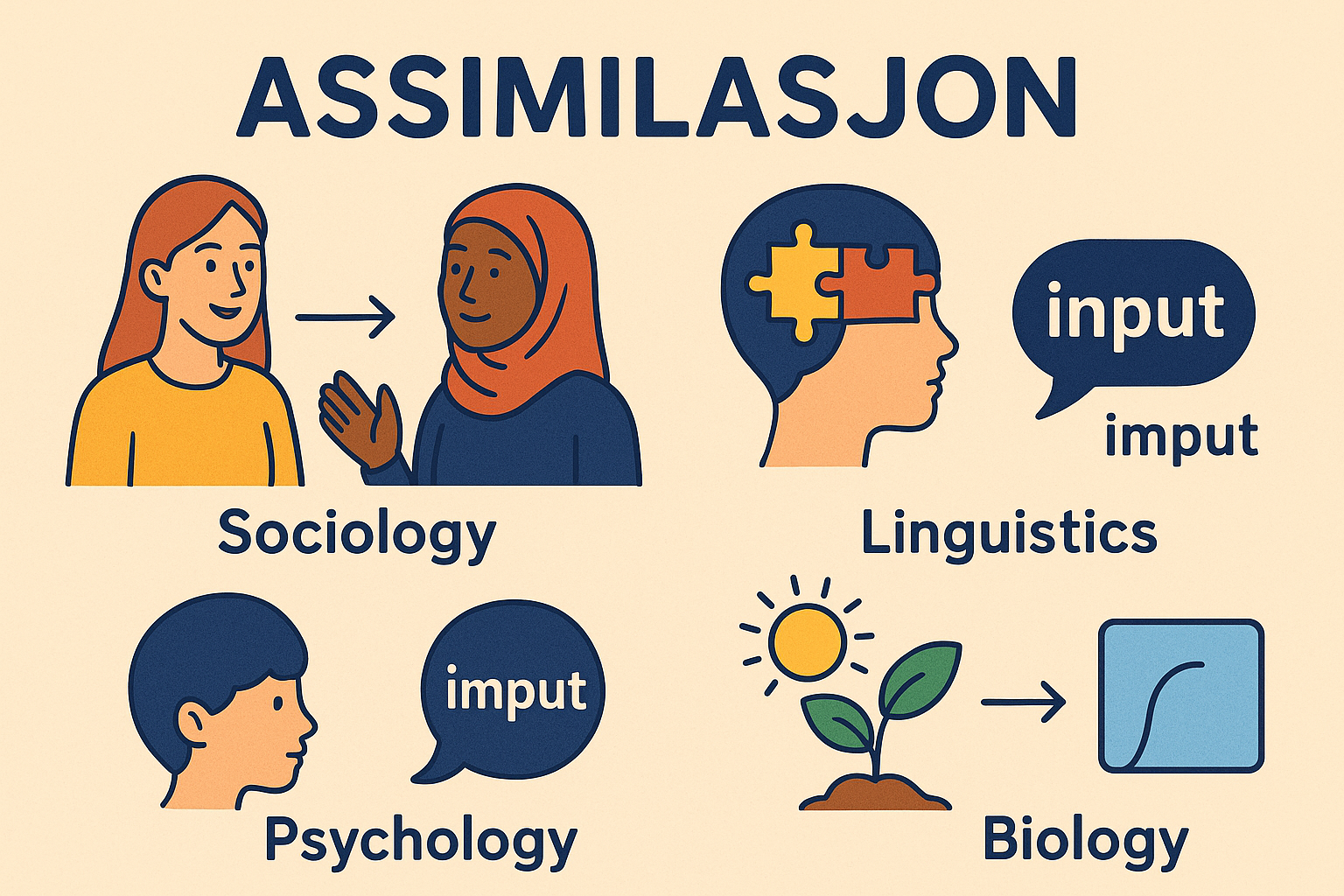Assimilasjon – Understanding the Concept, Its Processes, and Its Importance in Society, Language, and Science
The term Assimilasjon comes from the Latin word assimilare, which means “to make similar” or “to cause to resemble.” It is a multifaceted concept used across various disciplines, including sociology, psychology, linguistics, and biology. At its core, assimilasjon refers to a process where an individual, group, sound, or substance becomes more like another through adaptation, absorption, or integration.
In social sciences, it often describes how minority groups or immigrants adopt the cultural traits of a dominant society. In psychology, it refers to the cognitive process of integrating new information into existing frameworks. In linguistics, it describes how speech sounds change to become more like neighboring sounds. In biology, it relates to how organisms take in and use nutrients or convert substances into usable forms.
Understanding assimilasjon in these different contexts provides a deeper appreciation for how adaptation functions in both human and natural systems.
Assimilasjon in Sociology
In sociology, assimilasjon is primarily associated with cultural adaptation. It describes the process by which individuals or minority groups adjust to and adopt the customs, behaviors, and values of a majority culture. This can happen voluntarily, through social interaction, or involuntarily, through societal pressure or government policy.
There are several forms of sociological assimilasjon:
-
Cultural assimilasjon – Adoption of language, dress codes, traditions, and daily habits from the dominant culture.
-
Structural assimilasjon – Participation in the social, political, and economic institutions of the larger society.
-
Identificational assimilasjon – A shift in identity where individuals begin to see themselves primarily as members of the dominant culture.
Historically, many immigrant groups experienced pressure to assimilate in order to gain acceptance, avoid discrimination, or achieve upward mobility. However, critics argue that this process can lead to the erosion of original cultural identities, languages, and traditions.
Assimilasjon in Psychology
In psychology, the concept of assimilasjon is most closely associated with the work of Swiss developmental psychologist Jean Piaget. Piaget used the term to describe a cognitive process in which new experiences are interpreted and incorporated into existing mental frameworks, known as schemas.
For example, if a child has learned what a dog is and encounters a wolf for the first time, the child might initially classify the wolf as a dog because it shares similar characteristics. This is assimilasjon — fitting new information into an existing schema.
Assimilasjon works hand-in-hand with accommodation, another of Piaget’s key concepts. While assimilasjon adapts new experiences to fit existing frameworks, accommodation involves changing the framework itself to account for new information. Together, these processes explain how humans learn and adapt cognitively.
Assimilasjon in Linguistics
In linguistics, assimilasjon refers to a phonological process in which one sound becomes more similar to a neighboring sound. This can occur in terms of place of articulation, manner of articulation, or voicing.
An example in English is the phrase “input,” which is often pronounced as “imput,” with the n sound changing to m before the p sound. This change happens because the mouth’s position for m is closer to that of p than n is, making speech more efficient.
Assimilasjon in linguistics is a natural phenomenon that helps make speech smoother and faster. It can be progressive (a sound is influenced by a preceding sound) or regressive (a sound is influenced by a following sound).
Assimilasjon in Biology
In biology, assimilasjon describes the process by which living organisms take in substances and transform them into materials they can use for growth, energy, and repair.
For animals, assimilasjon occurs after digestion — nutrients from food are absorbed into the bloodstream and transported to cells, where they are used for various biological functions.
In plants, assimilasjon often refers to photosynthesis, where carbon dioxide from the atmosphere is converted into glucose using sunlight and chlorophyll. This is essential not only for plant growth but also for life on Earth, as it forms the basis of the food chain.
Benefits of Assimilasjon
While the impacts of assimilasjon vary depending on context, several potential benefits can be identified:
-
Social cohesion – In multicultural societies, assimilasjon can reduce cultural barriers and foster unity.
-
Economic opportunity – Learning the dominant language or customs can improve access to jobs, education, and resources.
-
Communication efficiency – In linguistics, assimilasjon helps speech flow more smoothly.
-
Survival and adaptation – In biology, assimilasjon ensures that organisms can use resources from their environment effectively.
Drawbacks and Criticisms of Assimilasjon
Despite its benefits, assimilasjon can also have negative consequences:
-
Loss of cultural identity – Minority groups may lose language, traditions, and customs over generations.
-
Cultural homogenization – Unique cultural differences can disappear, leading to a less diverse society.
-
Forced assimilation – When imposed through laws or social pressure, assimilasjon can be a form of cultural oppression.
These drawbacks are particularly relevant in modern discussions about immigration and multiculturalism. Many advocates argue for integration rather than complete assimilation, allowing individuals to participate fully in society while preserving their heritage.
Assimilasjon vs. Integration
Assimilasjon and integration are often confused, but they represent different approaches to cultural adaptation. Assimilasjon implies that a minority group adopts the dominant culture to the point of losing its original identity. Integration, on the other hand, encourages participation in the broader society while retaining one’s unique cultural characteristics.
Many modern societies aim for integration because it supports both social harmony and cultural diversity, creating environments where multiple traditions can coexist.
Historical Examples of Assimilasjon
History offers numerous examples of assimilasjon:
-
The Roman Empire – Conquered peoples often adopted Roman laws, language, and customs.
-
Colonialism – Indigenous populations were frequently forced to adopt the culture, language, and religion of colonial powers.
-
The American “melting pot” – Immigrants in the 19th and early 20th centuries were expected to become “American” by adopting English and embracing mainstream cultural values.
These examples show that assimilasjon can be both voluntary and forced, peaceful and coercive.
Assimilasjon in a Globalized World
Today, globalization has accelerated cultural exchange and, by extension, assimilasjon. Digital communication, international travel, and global markets spread languages, fashions, music, and lifestyles rapidly. While this can promote mutual understanding, it also raises concerns about the disappearance of local cultures and languages.
Balancing the benefits of global cultural exchange with the preservation of cultural diversity remains one of the great challenges of the modern era.
Read also: Canon FL No.138758 – Complete Historical, Technical, and Collector’s Guide
Conclusion
Assimilasjon is a complex and multifaceted concept that appears in disciplines ranging from sociology and psychology to linguistics and biology. Whether it involves cultural adaptation, cognitive development, phonological changes, or nutrient absorption, the essence of assimilasjon is transformation through similarity.
In human society, the debate over assimilasjon versus integration is ongoing. While some degree of assimilasjon can promote unity and opportunity, preserving cultural identity is equally vital for maintaining diversity and heritage. Understanding the different forms and implications of assimilasjon helps individuals and societies navigate the delicate balance between adaptation and cultural preservation.














Post Comment